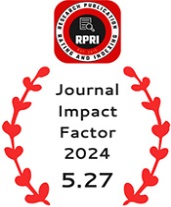The Renaissance of Karbi Anglong: Indigenous Governance, Cultural Revitalization, and Sustainable Development in Assam's Autonomous Highland Region
DOI:
https://doi.org/10.55544/ijrah.5.3.7Keywords:
Indigenous governance, autonomous development, cultural heritage, sustainable development, Sixth Schedule, Northeast India, traditional knowledge systemsAbstract
This comprehensive research examines the Karbi Anglong Autonomous District Council (KAAC) region of Assam, India, as an exemplary case of indigenous governance fostering cultural preservation alongside transformative development. Through rigorous analysis of historical contexts, geographical attributes, socioeconomic indicators, governance innovations, and emerging development paradigms, this paper reveals Karbi Anglong's extraordinary potential trajectory toward becoming a model of sustainable indigenous-led development. The autonomous framework established under the Sixth Schedule of the Indian Constitution provides a robust institutional architecture that, when properly activated, can catalyze multidimensional development while safeguarding the rich cultural heritage that constitutes the region's identity. Utilizing both qualitative and quantitative methodologies, this research demonstrates how Karbi Anglong represents a living laboratory for the harmonious integration of traditional knowledge systems with contemporary development approaches. The findings contribute significantly to the discourse on indigenous governance systems globally and offer actionable insights for policymakers, development practitioners, and local stakeholders engaged in similar contexts worldwide. This research establishes that Karbi Anglong stands at the threshold of a developmental renaissance that could transform it into a globally recognized exemplar of culturally-rooted sustainable development.
Downloads
References
Ahmed, M. F., Das, A., & Dutta, S. K. (2018). Amphibian diversity and distribution in Karbi Anglong, Assam, Northeast India. Journal of Threatened Taxa, 10(13), 12853-12865.
Agricultural Census. (2015). Agricultural Census of Karbi Anglong. Directorate of Economics and Statistics, Government of Assam.
Agriculture Department, KAAC. (2021). Annual Report 2020-21. Karbi Anglong Autonomous Council.
Animal Husbandry Department, KAAC. (2021). Indigenous Livestock Development Program: Status Report. Karbi Anglong Autonomous Council.
Arora, V. (2007). Unheard voices of peace in the Northeast: The politics of the Sixth Schedule. Economic and Political Weekly, 42(22), 2023-2031.
Assam Energy Development Agency. (2019). Renewable Energy Resource Assessment: Karbi Anglong District. Government of Assam.
Baruah, S. (2005). Durable Disorder: Understanding the Politics of Northeast India. Oxford University Press.
Baruah, S. (2020). In the Name of the Nation: India and Its Northeast. Stanford University Press.
Bhattacharjee, J. B. (1986). North-East India: The Evolution of a Post-Colonial Region. Manas Publications.
Bhaumik, S. (2009). Troubled Periphery: Crisis of India's North East. Sage Publications.
Census. (2011). District Census Handbook: Karbi Anglong. Office of the Registrar General & Census Commissioner, India.
Constituent Assembly Debates. (1949). Debates on the Sixth Schedule provisions. Government of India.
Crystal, D. (2000). Language Death. Cambridge University Press.
Das, K., & Hussain, M. (2019). Economic valuation of cultural resources in Karbi Anglong, Assam. Indian Journal of Traditional Knowledge, 18(3), 535-545.
Department of Handloom and Handicrafts, KAAC. (2020). Craft Sector Development Report. Karbi Anglong Autonomous Council.
District Census Handbook. (2011). Karbi Anglong District Census Handbook. Office of the Registrar General & Census Commissioner, India.
Education Department, KAAC. (2020). Multilingual Education Initiative: Evaluation Report. Karbi Anglong Autonomous Council.
Education Department, KAAC. (2021). Annual Status Report on Education. Karbi Anglong Autonomous Council.
Energy Department, KAAC. (2020). Renewable Energy Master Plan for Karbi Anglong. Karbi Anglong Autonomous Council.
Energy Department, KAAC. (2021). Annual Report on Energy Development Initiatives. Karbi Anglong Autonomous Council.
Environment Department, KAAC. (2021). Ecosystem Services Valuation and Payment Program: Progress Report. Karbi Anglong Autonomous Council.
Fairclough, N. (2013). Critical Discourse Analysis: The Critical Study of Language. Routledge.
Finance Department, KAAC. (2021). Annual Financial Statement 2021-22. Karbi Anglong Autonomous Council.
Forest Department, KAAC. (2020). State of Forest Report: Karbi Anglong. Karbi Anglong Autonomous Council.
Forest Department, KAAC. (2021). Forest Certification Project: Status Report. Karbi Anglong Autonomous Council.
Gait, E. (1926). A History of Assam. Thacker, Spink & Co.
Gassah, L. S. (1997). The Autonomous District Councils. Omsons Publications.
Geological Survey of India. (2015). Geology and Mineral Resources of Karbi Anglong, Assam. Government of India.
Goswami, D. C., Goswami, I. D., & Duarah, B. P. (2018). Climate variability and its impact on agriculture in Karbi Anglong district of Assam. Journal of Agrometeorology, 20(3), 223-229.
Health Department, KAAC. (2021). Healthcare Development in Karbi Anglong: Status Report. Karbi Anglong Autonomous Council.
Infrastructure Department, KAAC. (2021). Comprehensive Transportation Plan for Karbi Anglong. Karbi Anglong Autonomous Council.
IT Department, KAAC. (2021). Digital Governance Report 2020-21. Karbi Anglong Autonomous Council.
KAAC. (2015). Traditional Institutions (Recognition) Act. Karbi Anglong Autonomous Council.
KAAC. (2019). Handbook on Council Composition and Functions. Karbi Anglong Autonomous Council.
KAAC. (2020). KAAC Act Amendments 2020: Explanatory Memorandum. Karbi Anglong Autonomous Council.
Knowledge Management Cell, KAAC. (2021). Knowledge Management Strategy and Implementation Report. Karbi Anglong Autonomous Council.
Kumar, M., & Borah, P. (2020). Organic agriculture and market linkages in Karbi Anglong. Economic and Political Weekly, 55(26-27), 58-65.
Kumar, P., Kumar, M., & Garrett, L. (2020). Valuing ecosystem services in Karbi Anglong watersheds. Ecological Economics, 176, 106-118.
Land Resource Department, KAAC. (2020). Land Use Planning for Sustainable Development. Karbi Anglong Autonomous Council.
Lyall, C. (1908). The Mikirs: From the Papers of Edward Stack. David Nutt.
Maffi, L. (2005). Linguistic, cultural, and biological diversity. Annual Review of Anthropology, 34, 599-617.
Marketing Department, KAAC. (2021). Agricultural Marketing Initiatives: Impact Assessment. Karbi Anglong Autonomous Council.
Nakashima, D. J., Galloway McLean, K., Thulstrup, H. D., Ramos Castillo, A., & Rubis, J. T. (2012). Weathering Uncertainty: Traditional Knowledge for Climate Change Assessment and Adaptation. UNESCO.
National Institute of Solar Energy. (2019). Solar Resource Assessment for Northeast India. Ministry of New and Renewable Energy, Government of India.
NTFP Development Corporation. (2021). Annual Report on NTFP Development in Karbi Anglong. Karbi Anglong Autonomous Council.
Phangcho, P. C. (2003). The Karbis of Northeast India. Angik Publications.
Phangcho, P. C. (2018). Traditional jurisprudence and conflict resolution mechanisms among the Karbis. Journal of Northeast Indian Studies, 8(1), 18-32.
Planning Department, KAAC. (2021). Development Status Report 2020-21. Karbi Anglong Autonomous Council.
Ramakrishnan, P. S. (2007). Traditional forest knowledge and sustainable forestry: A north-east India perspective. Forest Ecology and Management, 249(1-2), 91-99.
Ramakrishnan, P. S., Saxena, K. G., & Rao, K. S. (2007). Shifting Agriculture and Sustainable Development of North-East India: Tradition in Transition. UNESCO and Oxford & IBH.
Reid, R. (1942). History of the Frontier Areas Bordering on Assam from 1883-1941. Government of India Press.
Rural Development Department, KAAC. (2021). Community Asset Building Program: Status Report. Karbi Anglong Autonomous Council.
Sarmah, B. (2002). The Sixth Schedule and autonomous district councils of Northeast India. Indian Journal of Political Science, 63(2), 139-154.
Sharma, N. (2010). Prehistoric archaeology of the hills of North-East India. Man and Environment, 35(2), 27-42.
Sharma, T. C. (2019). The Sixth Schedule and tribal autonomy in Northeast India. Economic and Political Weekly, 54(29), 45-52.
Skill Development Department, KAAC. (2021). Skill Development Initiatives: Progress Report. Karbi Anglong Autonomous Council.
Teron, D. (2011). Karbi Studies. Assam Book Trust.
Teron, D. (2019). Cultural documentation and preservation in Karbi Anglong. Journal of Cultural Heritage Management, 11(2), 145-159.
Teron, R., & Borthakur, S. K. (2012). Traditional knowledge of herbal dyes and cultural significance of colors among the Karbis ethnic tribe in Northeast India. Ethnobotany Research and Applications, 10, 593-603.
Teron, R., & Borthakur, S. K. (2014). Ethnobotanical appraisal of the Karbis of North East India. Pleione, 8(2), 269-281.
Teron, D., & Singha, K. (2018). Karbi-English-Assamese Dictionary. Assam Academy for Cultural Relations.
Throsby, D. (2001). Economics and Culture. Cambridge University Press.
Tourism Department, KAAC. (2021). Tourism Development Report 2020-21. Karbi Anglong Autonomous Council.
UNESCO. (2018). Culture for the 2030 Agenda. United Nations Educational, Scientific and Cultural Organization.
Water Resources Department, KAAC. (2021). Water Security Initiative: Implementation Report. Karbi Anglong Autonomous Council.
Downloads
Published
How to Cite
Issue
Section
License
Copyright (c) 2025 Prof. Dr. Harikumar Pallathadka, Dr. Parag Deb Roy, Dr. Saumya Shankar Chowdhury

This work is licensed under a Creative Commons Attribution-NonCommercial-NoDerivatives 4.0 International License.




















